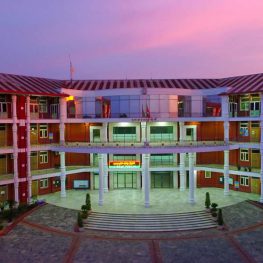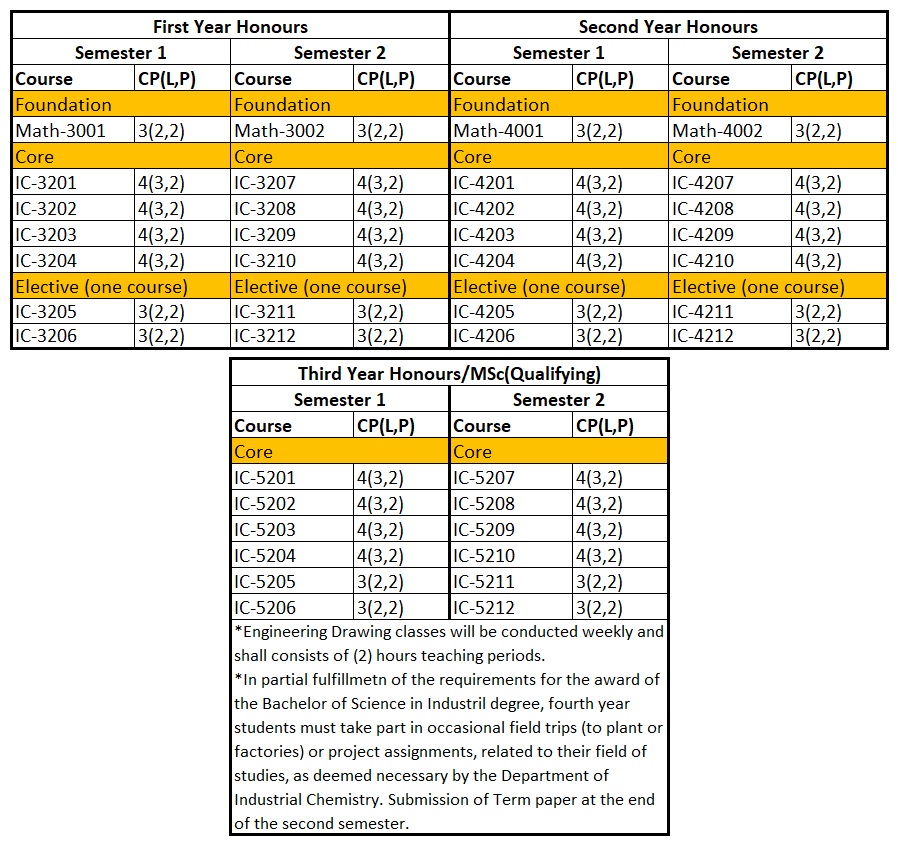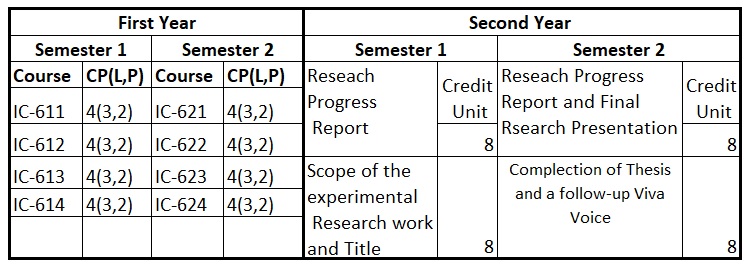Categories
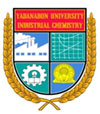 Department of Industrial Chemistry
Department of Industrial Chemistry
 |
Dr Aye Pa Pa Win Professor Ph.D (Industrial Chemistry) Department of Industrial Chemistry, Yadanabon University, Mandalay, Myanmar (+95 95504253) ayepapawin.aw27@gmail.com |
Staff
| Professor | – | 1 |
| Associate Professor | – | – |
| Lecture | – | 5 |
| Assistant Lecturer | – | – |
| Demonstrator | – | 6 |
| Office Staff | – | 1 |
| Total | – | 13 |
History of the Department
The Industrial Chemistry Department, Yadanabon University was founded in 2000, the year of establishment of Yadanabon University. The department of Industrial chemistry offers B Sc, B Sc (Honours) and M Sc in Industrial Chemistry.
Vision
- To nature and develop capacity and talents in the field of Applied Sciences and eventually become the main driver for the sustainable development of the Applied Sciences- based Economic system.
Mission
- To train and build up the students to be creative and good industrial chemists and researchers
- To engage technology transfer to local and regional communities
- To provide in any way for the industrialization of the country
Programs Offered
| BSc. / BSc. (Hons) in Industrial Chemistry |
| MSc. in Industrial Chemistry |
Curriculum
BSc in Industrial Chemistry
BSc. (Hons) in Industrial Chemistry
Students who passed second year with GPA greater than 4 are eligible to attend BSc. Honours classes for three more years. After finished successfully, they are earned BSc. (Hons) degree majoring in Industrial Chemistry.
MSc in Industrial Chemistry
Students who passed BSc (hons) with GPA greater than 4 are eligible to attend MSc. Classes for two more years. After finished successfully, they are earned MSc degree majoring in Industrial Chemistry.
Descriptions Modules Offered
This module composed of two main components, organic chemistry and analytical chemistry. Organic chemistry course aims to understand fundamental principles, preparation and reactions of organic compounds and their derivatives. Analytical chemistry course aims to learn the quantitative analysis of the substances. Students can study about acids and bases, hydrolysis; theory of neutralization; acid-base titrations and the use of indicators, titration curves; ionic equilibria; the dilution law; dissociation constant of weak acids and weak bases; buffer solutions; quantitative treatment of salt hydrolysis; the solubility product; precipitation titrations; application of organic chelating reagents to volumetric analysis, and chromatography.
This module aims to learn inorganic chemistry and physical chemistry. Inorganic chemistry course includes introduction to material science, chemical metallurgy; extraction of some metals from ores and alloys. Physical chemistry course aims to learn about the kinetic molecular theory; chemical equilibrium; surface chemistry; electrochemistry and electrolytic refining and electroplating of metals; dynamic electrochemistry.
This module aims to learn the chemistry of aromatic compounds. In addition, students enable to learn about various natural polymers such as carbohydrate and protein.
The module covers the fundamental concepts of chemical process related to the phenomenon of fluid flow.
Students can also study from this module about Industrial Equipment for Chemical Processes; Flow of Fluids; Size Separation; Size Reduction; and Sedimentation which are important unit operations in industries.
This course introduces the chemical engineering calculations. It deals with the material and energy balance of a chemical process using chemical analysis.
This module aims to understand chemical thermodynamics and its related laws. It also includes the phase rules which are applicable to distillation and fractional distillation, and the criteria of catalysis.
These modules cover heat transfer by conduction, convection and radiation with their related laws, the fundamental concepts of chemical process related to the phenomenon of fluid flow. In addition, evaporation in steam boiler, type of boilers, heat transfer coefficient in evaporation, liquid film coefficients, scale, multiple effect evaporation, properties of steam, estimation of dryness fraction and related problems will be studied.
This module concerns with the fuel science and technology. It covers the fuels such as fossil fuel: solid, liquid and gaseous fuel used in most of the industries. Their origin, sampling, properties, processing, testing, analysis, mechanism of combustion and combustion calculation, subsequent atmospheric pollution, air pollution and methods of pollution control will be discussed in this module.
This module aims to know about Natural Waters; Physical, Chemical and Biological Characteristics of Water; Water Quality Standards for Surface Water, Drinking Water and Water Supply Sources. In addition, student will be able to learn specifically on Methods of Water Treatment.
These modules deal with converting raw materials into products by processes such as Hydrolysis, Esterification and Oxidation. The module aims to facilitate the student’s transition from the university classroom to an industrial environment.
These modules aim to learn separation processes such as distillation, extraction and absorption to isolate a substance from a mixture. It involves the study of the fundamental principles of diffusion phenomenon and mass transfer. This unit also provides the equipment, different methods of computation and thermodynamic conditions related to the necessary experimental design.
These modules deal with the principles of physics in Chemical Reaction. These modules aim to learn Principles and Concepts of Chemical Kinetics of Reactions: Rate Equation, Order of Reaction and Rate Constant; Theory of Reaction Rates, and Experimental Methods for the Determination of Reaction Rates.
These modules aim to learn about Petrochemicals such as olefins, aromatics, synthetic gas, synthetic fibers, synthetic detergents, carbon black, petroleum wax which are chemicals derived from petroleum. These modules also include to learn methanol plant and the oil and gas based industries.
These modules provide the fundamental principles and current practices in water processing and wastewater treatment. These modules cover filtration, boiler feed water treatment and disinfection, evaluation of wastewater; preliminary treatment, screening, Grit removal, sedimentation, floatation, filtration, biological treatment methods, trickling filter, activated sludge. The objective is to transfer knowledge of these modules to persons interested in continuing their study in sanitary technology and engineering and to persons interested in operations and manufacture of water and wastewater facilities.
These modules aim to learn the unit processes such as Nitration, Sulfonation and Sulfation to synthesize the usable organic compounds from raw materials.
Unit operations IV are concerned with those separation processes Extraction: Liquid-Liquid Extraction and Leaching. These modules also cover Extraction Equipment, Computational Methods; and Absorption: Absorption Equipment, Properties of Tower Packing, Types of Tower Packing, Two-phase Flow through Packed Towers, Gas Absorption in Packed Towers — Material Balance, Rate Equations, Overall Mass Transfer Coefficients, and Concept of a Transfer Unit.
These modules aim to know about the industrial physical chemistry that is usable for the construction of the chemical reactors and it is inextricably associated with all chemical reactions and, therefore, is particularly important in the study in practice of unit processes. The module is designed to learn about Chemical Reaction Engineering; Reactor Design- Introduction to Reactor Design, Single Ideal Reactors; Heat Effects; and Flow Behavior of Reactor.
Plastics form a very large, comprehensive family with a wide range of properties that can meet almost every requirements of the packaging industry. This module concerns with the raw materials, types and characteristics of plastics, manufacture of plastics and quality control are conducted.
This module covers economic principles, cost estimation, cost analysis and elementary accounting procedures to estimate comparative annual costs, earning rates, total capital investment and product costs.
These modules deal a broad sense on Hydrogenation and Polymerization for converting raw materials into usable products. Detailed discussion of manufacturing process is included only to the extent required for the elucidation of the basic principles.
Unit operation V are concerned with those separation processes that depend either upon a difference in composition of phases at equilibrium or upon a difference in the rate of mass transfer of constituents of a mixture. These modules cover Filtration and Filters and Crystallization: Formation of Nuclei, Crystallization Equipment, and the Problems.
This module offers some important topics such as the Nitrogen-based Industries (Fertilizers); Fats and Oils Technologies and Soap; and Detergents and Related Compounds. It addition, students enable to learn Research Methodology.
These modules deals with some chemical industries such as Chlor-alkali Industry, Hydrochloric Acid and The Sulphur Industries which are important in the economy of any industrialized nation for the production of chemicals used in household commodities and utensils, industrial materials and components, medicines and drugs.
The module is a continuation study of IC 4101/ 4201 that covers economic principles and elementary accounting procedures. Detail topics are: Economics of Selecting Alternates; Economic Balance of Industrial Processes; Economic Analysis of a Process; Selection of Site for an Industrial Plant; and Industrial Management. They also illustrate the techniques in applying the principles to problems of the various types that are encountered by the process engineer in practice.
This module deals with converting raw materials into usable products by the mechanisms of Polymerization and Alkylation of organic compounds.
Unit operations VI are concerned with Drying, a separation process that depends upon differences in physical properties, rather than chemical behavior. The modules also cover General Drying Principles, Classifications of Dryers, and Design Calculation.
The module deals with Introduction to material science and nuclear chemistry and nuclear fuels as natural radioactivity, radioactive decay. Nuclear stability, binding energy and nuclear energy can be studied. Fundamentals of corrosion, qualitative ideas, electromotive series of standard electrode potentials, thermodynamics corrosion theory, extended thermodynamic — EH/pH diagrams, protection, cathodic and anodic protection, preventive measures can be studied.
This module is a continuation in the study of chemical process industries and deals with Pulp and Paper Industries, and Cosmetics Industry.
IC 5201 & IC 5207: Process Engineering Economics and Plant Design I & II
Chemical engineering plant design is neither a unit operation nor a unit process, but must be considered as one of the tools of the chemical engineering profession. The designed plant is based not only upon the application of accurate fundamental principles and data but also upon the economic phases of the process with emphasis being placed upon costs as an important factor in plant design. By studying the former module, students enable to learn General Design Considerations; Cost Estimation in Relation to Optimum Design; Materials Transfer; Handling and Treatment Equipment and Design, and Costs of the design. The later module concerns with Designs and Cost of Heat-Transfer Equipment and Mass-Transfer Equipment.
These modules are concerning with studies on unit processes in details. Former module is a continuation of the module, IC 4208, that concerns with Alkylation. Later module covers Hydrocarbon Synthesis and Hydroformylation; Halogenation; and Amination by Reduction.
The purpose of this module is enable student to familiarize with modern techniques and including Theories, Instrumentation and Applications of UV, IR and NMR. Then, students will apply this knowledge to determine the functional group present in some food and cosmetic products. These are now becoming a very valuable analytical tool to the organic chemist and biochemist.
The module, IC 5204 deals with Food Product Industries that includes Juice-making, Jams and Candied Fruits (Preserved)-making. In addition, it covers Sauces and Spices-making and their Preservation, Spoilage and Canning. These modules also cover Food Safety, Risk and Hazard Analysis; Food processing and Environment; Properties and requirements of processing water; Waste solid upgrading and Treatment. The module, IC 5210 aims to know more about chemical processes; Industrial Gases and Industrial Planning and Analysis.used in industries for industrial gases and also covers about various types of fixatives; fragrances or essential oils, flavors and their extractions from various sources for Perfume and Flavoring Industries.
The module deals with Solid Fuel Based Synthetic Fuels; Coal Briquettes; Coal-Water Mixture (CWM) and Colloidal Fuel; Liquid Fuel: Petroleum Based Hydraulic Fluids and Synthetic Hydraulic Fluid; Gaseous Fuel; Gasification Processes; Methane Reforming and Methane Synthesis; Gas Burner Design; Calculation of Flammability Characteristics of Hydrocarbons and Alcohols; Fissile Fuel; Nuclear Fuels and Fuel Cycles; Energy Conversion by Nuclear Reactions; and Radiation Hazards. In addition, students enable to learn Fuel Science Process of Combustion; Statistical Approach to Combustion Calculations; Calculation of Chimney Heights; and Maximum Gas Concentration at Ground Level (GLCmax).
IC 5206 aims to learn about the Characteristics of Bio-Products and Lipid Biosynthesis. IC 5212 covers Fermentation Technology and Industrial microbiology for the production of Food and Enzymes by Microorganisms and Other uses of Microorganisms.
Unit operations as valuable to the operating engineer as to the designer, since all industrial operations, or plants, are composed physically of a series of unit operation in their proper sequence. In this course, chemical reactors, industrial furnaces, dryers, commercial reactor design and uses can be learnt. The purpose of this module is to enable students to know mechanisms of dryers and furnaces and how to operate them.
The purpose of this module is to enable students to familiarize with Environmental Science. It explains about environment that affect ecosystems and human life; the impacts of human activities on various aspects of environmental quality; and the environmental economic and cultural factors that shape urban development. It also reveals the effect of weather on pollution, chemical reaction in the atmosphere and stratospheric ozone. This course aims to understand how to prevent the forest damage and increase the amount of carbon dioxide in the atmosphere can cause the weather changes and also acid rain. In addition, students will learn more specific on Effect of Weather on Pollution; Mist, Fog and Smog; Chemical Reaction in the Atmosphere; Stratospheric Ozone; Air Pollution and Solid Waste.
This module covers fruit and vegetable processing for improving the nutritional quality of processed fruits and vegetables; modeling fruit and vegetable production; maximizing the quality of thermally processed fruit and vegetable and for safety of cooked chilled foods. This module also introduces food process engineering related to Low Temperature Preservation, Solid Processing and Particles Manufacture, Mixing and Separation. Fats and oil technology and their physico-chemical properties are also included in this course.
This module gives the principles and concepts related to phase separation: Gas Liquid separation Process; Vapor Liquid Separation Processes; Liquid-Liquid and Fluid-Solid Separation Processes. It covers Evaporation; Membrane Separation processes, Mechanical-Physical Separation Processes.
The course deals with the General Biochemistry; Biochemical Process Technology; Environmental Biotechnology; Food and Enzymes from Microorganisms. It aims to learn the metabolism of carbohydrate and amino acids; principle of fermentation; cell biomass; wastewater treatment, enzymes technology; Bioremediation.
This module includes to learn about Pesticides; Persistent Organic Pollutants: Green Chemistry and Technology; Environmental Pollution Control Engineering; Pollution Control in Chemical and Allied Industries; Pollution Control in Food Processing Industries.
Tis module includes Chemical Process Industries and Industrial Stoichiometry. It aims to learn the production of ceramic, cement, glass, sugar and starch, pulp and paper, paint, varnish, lacquer and allied, leather, gelatin and glue, sulphur nitrogen compounds, lime and cement, and ceramics.
Energy Technology aim to learn about Energy Production from Fossil Fuels; Radioactivity and Radiation; Manufacturing of Petroleum Fuels and Energy and its Biological Resources. It covers about Nuclear power Plants; Ionization Radiation; Lubricating oil Blending; Synthetic Lubricants; Used Oil Refining: Lubricating Greases; Bioethanol; Low cost Biodiesels; Physical Properties of biodiesel Components and Processing of Vegetable Oil as Biodiesel.
This course describes Analytical Chemistry Instrumental Techniques. It includes studying the Principles of Chromatography and Analytical Spectroscopy.
Tis module aims to learn Applications of statistical methods Data Analysis and statistical Methods in Food and Consumer Research.
Teaching Aids & Labs
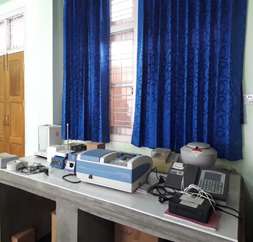 |
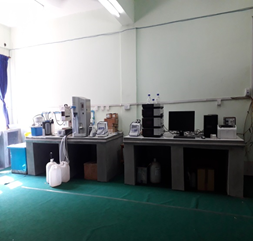 |
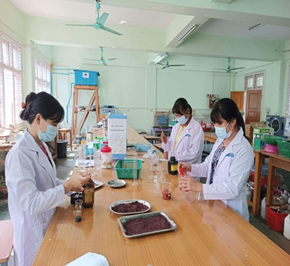 |
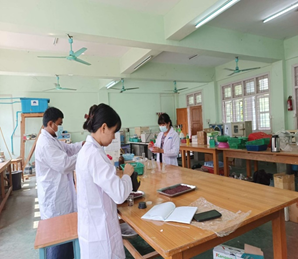 |
Books in Industrial Chemistry Library
- Farrington Doniels Robert A. Alberty (1955),”Physical Chemistry”
- K Sharma & L.K Sharma (1999),”A Textbook of Physical Chemistry”, Fourth Edition
- Princeton N.J (1940),”Physical Chemistry”, First Edition
- E Brain Smith (2013),”Basic Physical Chemistry”.
- Frank Keith & Mark S. Bohn, “Principles of Head Transfer “, Fifth Edition
- Christie J. Geankoplis (2000),”Transport Process and Unit Operation”, Third Edition
- V.Luikov (1980),”Heat and Mass Transfer “
- G Kyle, “Chemical and Process Thermodynamics”, Second Edition
- Binay K. Dutta (2001), “Heat Transfer Principles and Applications “
- Geoge Granger Brown (1995), “Unit Operations “, First Edition
- Robert E. Treybol, “Mass Transfer Operations”, Third Edition
- D Seader ,”Separation Process Principles “, Second Edition
- Christie John Geankoplis (2005), “Transport Process and Separation Processes Principle”, Fourth Edition
- KM Sahay,”Unit Operations of Agricultural Processing”, Second Edition
- Christie John Geankoplis (2005), “Transport Processes and Separation Process Principal (Industrial Unit Operation)”, Fourth Edition
- Frank P. Incropera David P. Dewitt, “Fundamental of heat and mass transfer”, Fourth Edition
- Donald Q Keln (1950), “Process Heat Transfer”
- Christie John Geankoplis (2014), “Transport Process and Separation Process”, Fourth Edition
- Mohn Gupta, “Fundamentals of Heat and Mass Transfer”
- Samuel Glasstone (1942),”An Introducing to Electro Chemistry”
- Mary Jones, Geoff Jones & David Acaster, “Coordinated Science Chemistry “, Second Edition
- Professor Ashok Panday (1998), “Advance in Biotechnology”
- S Bilgrami A.K. Pandy (1992), “Introduction to Biotechnology”, First Edition
- Stanley M. Walas, “Reaction Kinetic for Chemical Engineers”, International Student Edition
- James A. Kent , “Reigel’s Handbook of Industrial Chemistry”, Seventh Edition
- George T. Austin, “Shreve’s Chemical Process Industries “, Fifth Edition
- Sidney Siggia (1959), “Continuous Analysis of Chemical Process System”
- C Saunders and R.E.D Clark (1948), “Atoms and molecules simply explained: An Introduction to chemical Phenomena and their Applications “
- Donald J. Cram George’sS. Hannand(1959),”Organic Chemistry”, Second Edition
- Reynold C. Fuson (1962), “Reactions of Organic Compounds”
- L Finar, “Organic Chemistry Vol I”, Fourth Edition
- A.Geissman (1959), “Principles of Organic Chemistry”
- Addison Ault, “Techniques and Experiments for Organic Chemistry “, Sixth Edition
- Jag Mohan (2000), “Organic Spectroscopy”
- H Groggins, “Unit Process in Organic Synthesis”, Fifth Edition
- Prescott & Ridge (1961), “Organic Chemistry”
- Natis Haider, “Fundamentals of Organic Chemistry”
- R. Sharma (1980), “Elementary Organic Spectroscopy”, First Edition
- Charles A Mackenzie (1955), “Experimental Organic Chemistry “
- Sonial Ratnani Shriniwwas Gurjar (2012), “Experimental Organic Chemistry “
- Jag Mohan(2000), “Organic Spectroscopy, Principles and Application”
- Jag Mohan (2010), “Organic Spectroscopy”
- Stephen G.Davies, “Organotransition Metal Chemistry Application to Organic Synthesis Volume-2”, First Edition
- Ritter, “Persistent Organic Pollutants”
- Peter Orris, “Persistent Organic Pollutants and Human Health”, Fourth Edition
- Arthur I. Vogel, “A Text Book of Quantitative Inorganic Analysis”, Third Edition
- V.Khodakov, “Inorganic Chemistry (Textbook for schools)”
- Sulekh Chandra (2004), “Inorganic Chemistry”, First Edition
- Pradyot Patnaik (2005), “Handbook of Inorganic Chemicals”
- Bluncher,”Modern Industrial Chemistry”
- Sybil P. Parker (1986), “McGraw-Hill Dictionary of Chemistry “
- Philip Matthews (1996), “Advanced Chemistry “
- C A Heaton, “Chemical Industry”
- H Backett (2003), “Dictionary of Chemistry”
- Ventley and G.P.A Turner, “Introduction to Paint Chemistry and Principle of Paint Technology”, Fourth Edition
- A. Smiley (2002), “Chemistry and the Chemical Industry”
- V. Mark, “Chemical Process Industries Vol II”, Second Edition
- Cambridge University Press (2003), “Advanced Chemistry”, First Edition
- “Dictionary of Chemistry”, Second Edition
- KOTZ, John C, “Chemistry and the Chemical Reactivity”, Seventh Edition
- Heaton, Alan (1996), “An Introduction to Industrial Chemistry”, Third Edition
- E Hayes J.P.Mmbaga, “Introduction to Chemical Reactor Analysis”, Second Edition
- Scott Fogler (2014), “Elements of Chemical Reaction”, Fourth Edition
- Jame Clark & Duncan Macquarrie, “Green Chemistry and Technology”
- Sanjay K. Sharma Ackmez Muolhoo (2011), ‘’Green Chemistry for Environmental
Sustainability’’ - Stanley E.Manahan, (2006), “Green Chemistry and The Ten Commandments of Sustainability”, Second Edition
- Raymond Cooper George Nicola, “Natural Products Chemistry Sources, Separations, and Structures”
- K.Haghi.et.al. (2020), “Research Methodologies and Practical Applications of chemistry, Petrochemistry”, First Edition
- Cheke, A. Sheepaid (1997), “Cheese and Butter”
- Harold Egan Ronald S.kirk Ronald Sawyer (1981),Pearson’s Chemical Analysis of Foods,Eighth Edition
- Aylward (1999), “Food Technology Processing and Lab: Control”
- C Hersom & E.D. Hulland (1963), “Canned Foods”,Fifth Edition
- A. Weiss (1983), “Oilseed Crops”, First Edition
- Lillan Hoagland Meyer(1960), “Food Chemistry”
- G Davis (1999), “Milk Testing (The Laboratory Control of Milk)”
- Romeo T. Toledo (1999), “Fundamentals of Food Process Engineering” ,Second Edition
- American Oil Chemist’s Society , ‘’Official and Tentative Methods (Commercial Fats and Oils)’’
- American Oil Chemist’s Society (1984), “Official Methods and Recommended
Practices of the American Oil Chemist’s Society”, Third Edition - Lees (1975), “Food Analysis: Analytical and Quality Control Methods for the Food Manufacturer and Buyer” , Third Edition
- Jeanne Lesem (1886), “Preserving in Today’s Kitchen”
- Srilakshmi (2007), “Food Science”
- M Swaminathan (1986), “Handbook of Food and Nutrition”, Fifth Edition
- R Sen (2001), “Treatise on Analysis of Food, Fats & Oils”, First Edition
- Jethro Jagtiani (1988), “Tropical Fruit Processing”
- K. Salunkhe (1998), “Handbook of Vegetable Science and Technology”
- Sivasankar (2004), “Food Processing and Preservation” ,nSixth Edition
- N Shakuntala Manay, “Foods: Facts and Principles Book I”, Second Edition
- N Shakuntala Manay, “Foods: Facts and Principles Book II”
- Dominic W.S Wong (1996), “Mechanism and Theory in Food Chemistry”, First Edition
- CBS Publishers and Distributers (2005), “Fundamentals of Dairy Chemistry”, Second Edition
- Richardson (1985), “Chemical Changes in Food During Processing”
- William C Frazier (2010), “Food Microbiology”, Fourth Edition
- Sumati R. Mudambi (2006), “Food Science”, Second Edition
- Altone Bailey (1954), “Industrial Oil and Fat Products”
- Roger Wood, Lucy Faster (2004), “Analytical methods for Food Additives”
- Mircea Enachesu Dauthy (1995), “Fruit and Vegetable Processing”
- Miller, Jeanne (2009), “Food Science”
- Eben Fodor (2006), “The Solar Food Dryer”
- M.Ingledew (2009), “The Alcohol Text Book”, Fifth Edition
- Srilakshmi, “Food Science a Chemical Approach”, Third Edition
- G.Smith, “Food Process Engineering”
- Wim Jongen (2002), Fruit and Vegetable Processing
- Tamime (2008), “Cleaning in Place: Diary, Food, and Beverage Operations”, Third Edition.
- Semin Otles (2009), “Handbook of Food Analysis Instruments”
- Noel de Nevers (1945), “Air Pollution Control Engineering”
- K Agarwal (2012), “Air Pollution”
- Mark J. Hammer (1986), “Water and Waste-water Technology”, Second Edition.
- H. Galal-Gorchev & Mr.W.M.Lewis (1988), “Guidelines for Drinking Water Quality”
- Donald W.Sundstrom & Herbert E. Klei (1979), “ Waste water Treatment”
- Mark J. Hammer (2003), “Water and Waste-water Technology”, Fourth Edition
- Bsnraju (2000), “Water Supply and Waste water Engineering” , Second Reprint
- Alfred Z. Keller and Henry C. Wilson (1992), “Hazards to Drinking Water Suppliers”
- K N Duggal JP Soni (1996), “Elements of Water Resources Engineering”
- K Agarwal (2008), “Water Pollution”
- DONALD, Rhonda Lucas (2001), “Water Pollution”
- Anuradha Mishra and James Clark (2003), “Green Materials for Sustainable Water Remediation and Treatment Water Treatment Paper”
- Philip Roberts (2010), “Marine Wastewater Outfalls and Treatment System”
- A.Abbasi, Water quality sampling and analysis”
- Metcalf & Eddy (2003), “Wastewater Engineering”
- Bartram and Balance (1996), Water Quality Monitoring”, First Edition
- Glencoe (1997), “Earth Science”
- D TYAGI M.MEHRA(2000), “A Text Book of Environmental Chemistry”
- Ishchuk (2005), “Lubricating Grease”
- Wilfred Francis, “Fuels and Fuel Technology Vol I”
- C Macrae (1996), “An Introduction to the Study of Fuel”
- Van Gerpeh (2004), “Biodiesel Analytical Methods”
- C Macrae (1996), “An Introduction to the Study of Fuel”
- Brisiee, FJ (1912), “An Introduction to the Study of Fuel: a textbook for those entering the engineering, chemical and technical industries”
- Graeme M.Walker (2010), “Bioethanol: Science and Technology of Fuel Alcohol”
- Surinder Parkash (2010), “Petroleum Fuels Manufacturing ”
- Ahindro Nag (2008), ‘’Biofuels Refining and Performance ”
- Max S. Peters Klaus D.Timmerhaus (1991), “Plant Design and Economiics for Chemical Engineer”, Fourth Edition
- Henry cecil speneerJohn Thomas Dygdon (1968), “Basic Technical Drawing”
- F.C Pogers Y.R Mayhew (1967), “Engineering Thermodynamic Work and Heat Transfer”, Second Edition
- Rayner Jocl (1971), Basic Engineering Thermodynamics in SI Units”, Third Edition
- M Smith (1956), Chemical Engineering Kinetics”
- Robert Edgeworth Johnstone (1957), “Pilot Plants, Models and Scale Methods
in Chemical Engineering” - S.Aora (2003), “Academic’s Hand Book of Engineering Formulae and Definitions”, Second Edition
- Lynn D. Russell George A. Adebigi (1993), “Classical Thermodynamics”
- Ralkakrishnan (2000), “Fumdamentals of Engineering Thermodynamics ”
- C.Parkinson (1958), “First Year Drawing”, Sixth Edition
- Walter L. Badger & Julius T. Banchero (1995), “Introduction to Chemical Engineering”
- Sybil P. Parker (1997), “Mc-Grawhill Dictionary of Engineering”
- Esber I. Shabeen (1975), “Basic Practice of Chemical Engineering
- Edwin Williams & Curtis Johnson (1958), “Stoichiometry for Chemical Engineers”
- M Smith (1956), “Chemical Engineering Kinetics”
- S Peters (1958), “Plant Design and Economiics for Chemical Engineers”
- Nicholas P. Chopey (1994), “Handbook of Chemical Engineering Calculations”, Second Edition
- Gopalan(2005), “Text Book of Engineering Chemistry”, Second Edition
- Robin Smith (1995), “Chemical Process Design”
- Warren L. Mccabe (1993), “Unit Operation of Chemical Engineering” , Fifth Edition
- Esber I shabeen (1975), “Basic Practice of Chemical Engineering ”
- Syed Tanveer Ahmed Inandar (2007), “Biochemical Engineering (Principles and Concepts) ”
- Ciffany Wacson (2006), “Illustrated Dictionary of Chemical Engineering”, First Edition
- M Smith (1996), “Introduction to Chemical Engineering Thermodynamic”, Fifth Edition
- Walter L. Badger & Julius T. Banchero(1955), “Introduction to Chemical Engineering”
- M.R. Senapati (2009), “Advanced Engineering Chemistry”, Third Edition
- David M. Himmelblau(1996), ‘’Basic Principle and Calculations in Chemical Engineering’’, Sixth Edition
- John E. Bailey (1986), “Biochemical Engineering Fundamentals”, Second Edition
- C. Wals (1956), “Heat Engines (A First Text Book) ”, Fourth Edition
- Octave Levenspiel (1972), “Chemical Reaction Engineering”, Second Edition
- David M. Himmelblau.James B. Riggs(2013), “Basic Principle and Calculations in
Chemical Engineering”, Eighth Edition - Herbert E. Schweyer (1995), “Process Engineering Economics”
- Stanley M. Walas (1959), “Reaction Kitentics for Chemical Engineering”
- Frank G. Vilbronlt Charles E. Dryden (1959), “Chemical Engineering Plant Design”, Fourth Edition
- Edwin T. Williams R. Curtis Johnson (1958), “Storchiometry for Chemical Enginers”
- Professor of Chemical Engineering University of Floride (1955), “Process Engineering Economics”
- Kenneth E. Case Oklahoma State University (1998), “Engineering Economy”, Fourth Edition
- Peter Gevorlcion (2007), “Sustainable Energy System Engineering”
- M.Smith, H.C. VanNess, M.M Abbott (2005), “Introduction to Chemical Enginerring Thermodynamics”, Seventh Edition
- Jhon Rankin (2020), “Chemical Thermodynamics (Theory and Applications) ”
- Nicklin, K. Grame Cook, T. Paget (1999), “Instant Notes in Microbiology”, First Edition
- Wilson and Walker (2000), “Practical Biochemistry (Principles and Techniques) ”,Fifth Edition
- Prithipalsingh(2007), “An Introduction to Biodiversity”
- Harbans Lal (2011), “Textbook of Biochemistry”, Second Edition
- E. Smith (1996), “Biotechnology”, Third Edition
- John E. Smith (1996), “Biotechnology”, Third Edition
- N.Mukhopodhyay (2001), “Process Biotechnology Fundamentals”
- Stenesh (1989), “Dictionary of Biochemistry Molecular Biology”
- David Hames Nigel Hooper (2011), “Biochemistry Bios Instant Notes”, Fourth Edition
- Christoph Wittmann (2017), “Industrial Biotechnology”
- Andreas Vogel and Oliver May(2019), “Industrial Enzyme Applications”
- Gopala Rao Marshall Sittig(2002), ‘’Dryden’s Outline of ChemicalTechnology for the 21 Century”
- Jean-Francois Rozis(1997), “Drying Food stuffs (Techniques, Processes, Equipment) ”
- Morion Jacobs Fisk H.C William Endrsa(1982), “Introduction to Solar Technology”, Solar Drying: Fundamentals, Applications and Innovations”
- A. Niessen(2006), “Liquid Chromatography Mass Spectrometry, Third Edition
- Herbert Jhnstone(2003), “Mass Spectrometry Basics”
- L Comar & Felix Bronner(1962), “Mineral Metabolism ”
- Maria Szekely(1980), “From DNA to Protein: The Transfer of Genetic Information”, First Edition
- F Henderson and W.D Henderson (1998), “Dictionary of Sciences Terms”
- F Tweney & L.E.C Hughes, “Technical Dictionary”, Revised Edition
- BI BHATT SM VORA (1999), “Stoichiometry (SI Unit) ”, Sixth Edition
- S Athalye, “Plastic and Packing”
- 2007, English-Myanmar Dictionary” , Seventh Edition
- MERCK(2004), “ Laboratory Supplies Catalogue Chemicals, Reagents, Media and Other Products”
- I, J.D, E.A.M (1991), “Concise Science Dictionary” , Second Edition
- Gary A Smook (1992), “Handbook for Pulp and Paper Technologists”, Second Edition
- Frank Hamilton (1993), “Pulp and Paper Manufacture Vol.3 Secondary Fibers and non-wood Pulping” , Third Edition
- Asean and Japanese Perspectives (1999), “Industrial Development and Reforms in
Myanmar Robot, Design and Manufacture Stainless and Technology” - Schwaller & Gilberti (1996), “Energy Technology (Sources of Power) ”
- P Pandey (2000), “Economic Botany”
- F.Trelease (1969), vHow to Write Scientific and Technical Papers”
- Asean University Network (2011), “Asean University Network Quality Assurance
- Bioactive conjugated Linoleic acid glycerides and method of use”
- Lum Eisenman (1999), “The Home Winemakers Manual”
- R. Kothari (2004), “Research Methodology (Methods and Techniques) ”, Second Edition
- Khin Maung Lwin & Dr.Myat Kay Thwe Lwin (2015), “Medicinal Plantlist of Myanmar’’ , Second Edition
- D.Dunn (1978), “Appropriate Technology with a Human Book Face’’
- Willey-VCH (2008), “Renewable Energy’’
- Herbest H.Uhlig, ‘’Protective Coatings for Metals’’
- Norman Stark (1976), “The Formula Book’’, Sixth Edition
- Norman Stark (1976), “The Formula Book’’, First Edition
- Willey-VCH (2014), ‘’Advanced Synthesis & Catalysis’’
- Abd-El Rahman Khane (1978), ‘’Manual for the Preparation of Industrial
Feasibility Studies ‘’ - IRVING M.HAUG, CWS V (1996), ‘’Deionization Basics’’
- Mc Graw Hill (1998), ‘’Tubular Heat Exchanger Inspection, Maintenance, and Repair’’
- Qazi Shoeb Ahmad et.al (2015), ‘’Numerical and Statistical Techniques’’
- Bayer (2006), ‘’Science for A Better Life’’
- Marijin Dekkers (2015), ‘’Oncology: Therapies to beat cancer: Unleashing the immune response to tumors’’
- Werner Wenning(2020), ‘’Targeting Cancer Innovative concepts for tumor therapy’’, Seventh Edition
- Werner Wenning(2004), Sustainable Development Report
- Smith(2011), ‘’Fundamentals of Fourier Transform Inferared Spectroscopy’’, Second Edition
- Hidalgo-Alvarez (2010), ‘’Structure And Functional Properties of Colloidal Systems’’
- Robert Heidersbach (2018), ‘’Metallurgy and Corrosion Control in Oil and Gas Production’’, Second Edition
- Henry Tan, ‘’Liquid Chromatography Principles and Current Instrumentation’’
- D. Ramendra.et. al.(2020), ‘’Carbonaceous Materials and Future Energy’’
- Rolond Weber (2018), ‘’How to Prevent the Use of Toxic Chemicals frequently found in the Mediterranean region’’
- Henry Tan, ‘’Liquid Chromatography Principles and Current Instrumentation’’’
- Qingmin Ji Harald Fuchs (2020), ‘’Soft Matters for Catalysts’’
- Nairobi, Kenya (1985), ‘’Training Programme For Women Entrepreneurs’’
- K.Goel (2006), ‘’Water Pollution Causes, Effects and Control’’, Revised Second Edition
- I.M.Keulemars(1959), ‘’Gas Chromatography’’, Second Edition
- Victor L.Streeter(1958), ‘’Fluid Mechanics, Fifth Edition’’
- Tan Htaik, ‘’Scientific Project and Term Paper’’
- G.SMITH (2003), ‘’Introduction to Food Process Engineering’’
- Sivasankar (2009), ‘’Food Processing and Preservation’’, Sixth Edition
- Andy Bruce & Ken Langdon (2000), ‘’Project Management’’
- Than Toe (2001), ‘’Research Methodology A Practical guide for business and economics’’, First Edition
- K Sharma (1996), ‘’Problems in Physical Chemistry’’, Revised Second Edition
- Chand & CO (1961), Essentials of Physical Chemistry,Eleventh Revised Edition
- Jeanne Miller (2009), ‘’Food Science’’
- John Eddowens Bowman (1854), ‘’Introduction to Practical Chemistry, Including Analysis’’, Second Edition
- Daniel A.Okun and Christopher A.Shul (1984), ‘’Surface Water Treatment for Communities in Developing Countries’’
- Graham Weaver (1982), ‘’An Introduction to Materials’’
- Alireza Bahadori (2020), ‘’Waste Management in the Chemical and Petroleum Industries’’, Second Edition
- Dominic W.S Wong , ‘’Mechanism and Theory in Food Chemistry’’
- Metcalf & Eddy,Inc(2003), ‘’Wastewater Engineering Treatment and Reuse’’, Fourth Edition
- Fisher & J.R.P.Arnold (1999), ‘’Instant Notes in Chemistry for Biologists’’
- Melvil Dewey (1996), ‘’Dewey Decimal Classification and Relative Index’’
- John Wiley & Sons,Inc (1973), ‘’Sprigel and Lansburgh Industrial Management’’, Fifth
- Mackenzie L. Davis. David A, Cornwell(2008), ‘’Introduction to Environmental Engineering’’, Fourth Edition
- G Smith (2003), ‘’Introduction to Food Process Engineering’’
- Sivasankar (2009), ‘’Food Processing and Preservation’’ , Sixth Edition
- M Burns (1955), ‘’Protective Coatings for Metals’’
- Carlw-Hall (1983-1984), ‘’Drying Technology (Vol-2) (No 1-4)’’
- DEGN, L.Bal Slev, R.Brook (1974), ‘’Measurement of Oxygen’’
- D.Garn (1965), ‘’Thermoanalytical methods of investigation’’
- Jatt (1976), ‘’Polar Organic Oxygen Sensors’’
- Hussain Bin Mohd.Sallah (1990), ‘’Analysis of two commercial rice-drying systems under malaysian conditions’’
- S.Mu jumdan (1992), ‘’Drying’92 (part B)’’
- Than Htoon (2001), ‘’NVS Science Pharmacy’’
- B.Keey (1978), ‘’Introduction to Industrial Drying Operations’’
- Warnerhojmann (1989), ‘’Rubber Technology’’
- N.Mukhopodhyay, ‘’Process Biotechnology Fundamentals’’
- Rudinger, ‘’Fundamentals of gas- flow -particle flow’’
- Robert A.Greenwald (1989), ‘’Handbook of Methods for Oxygen Radical Research’’
- S.Mujumdor(1992), ‘’Drying (part A)’’
- A.S.Mujumdor (1991), ‘’Drying No-1,2’’
